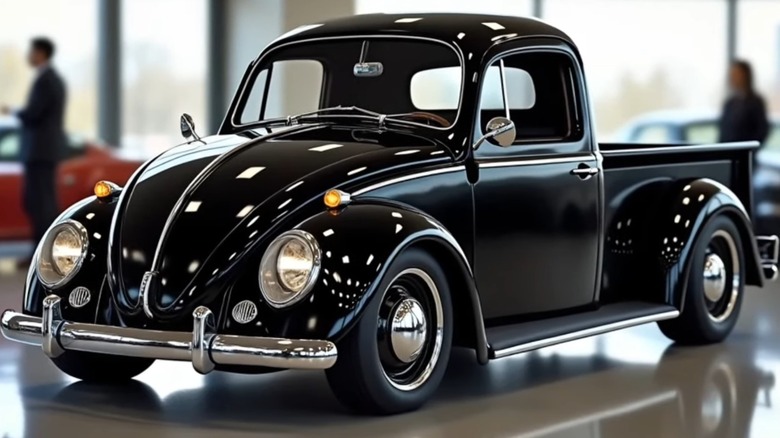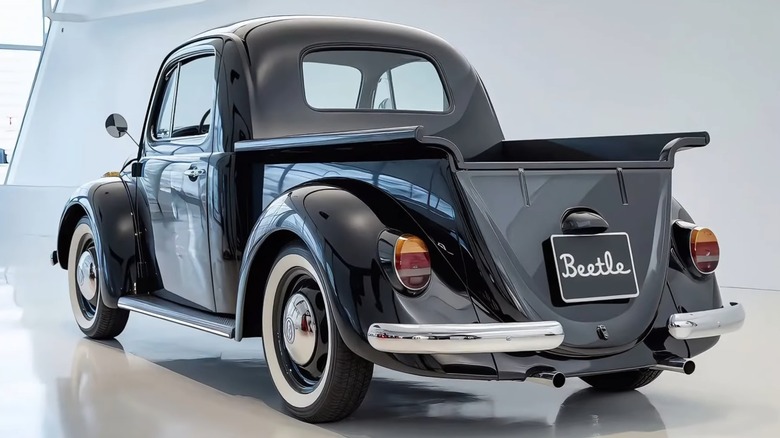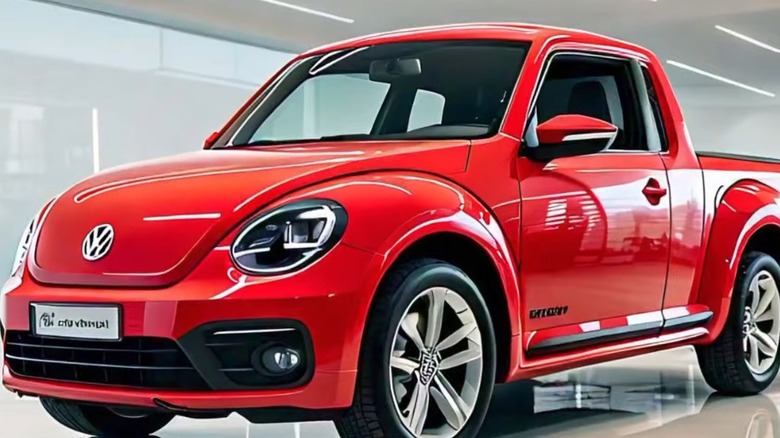Is Volkswagen Really Making A Beetle Pickup Truck?
The spirited little Volkswagen Beetle first entered the U.S. in 1950 and charmed Americans with its round headlights and curved body, which emulated the shape of a ladybug. This unique car saw its third and final generation end in 2019 when it was discontinued. However, a Volkswagen Super Bowl 2024 ad had some wondering if VW was bringing back the Beetle.
Now, videos have been surfacing of a new Beetle pickup truck, essentially a traditional "bug" front half with a pickup bed in the rear. But before Volkswagen fans get too excited, unfortunately, it's all just misleading, AI-generated fiction. And this is hardly the first example lately, as we've debunked several dishonest claims like the ones about a 2025 Dodge Dart and even one about the Lexus dually truck.
However, before any hopes are completely crushed, there is an aftermarket kit for sale that will allow you to transform your Beetle into a pickup called a "Ute." In addition, Volkswagen has actually produced a pickup before, called the Amarok, however, it was never made available in the U.S.
How to build your own Beetle Ute with a premade kit
As reported by Jalopnik, Volkswagen CEO Thomas Schäfer commented on the return of the Beetle by stating, "I don't think so, because there are certain vehicles that have had their day. It wouldn't make sense to bring it back." Considering the automaker isn't planning on bringing back the iconic vehicle, it's especially doubtful it would even think about a pickup variation. So, that means it's up to fans to bring a Beetle truck to fruition themselves.
Fortunately, Smythkitcars.com offers specialty kits that start around $3,000, enabling you to turn an existing Beetle into a Ute, which includes a rear pickup bed. While it will certainly be a project, the aftermarket retailer also offers build manuals and instructional videos free of charge to help ensure things progress smoothly. However, for those a bit intimidated with a do-it-yourself approach, Smyth can also build a Ute for you. Though this service will undoubtedly cost more than the kit, it remains another means for the dream of a Beetle truck to be realized.
Why do these fake, AI-made car videos keep popping up?
Artificial Intelligence is all the rage these days and seems to be getting implemented into nearly everything. We even noted some examples of the best and worst uses of AI we saw at CES 2024 last year. Sadly, one of its more insidious uses lately has been centered around creating fake vehicle images. A common thread through many of the recent fictional car announcement videos on social media is that they have used classic vehicle models that have been discontinued. This type of content preys on nostalgia, attempting to get as much attention from viewers longing for a return to an iconic part of their past.
Referred to as "clickbait," these videos are successful partly because the prospect of exciting news can engage certain dopamine paths in the brain, making people eager for a big revelation. These types of videos have become much easier to manufacture with AI image tools, which dramatically reduce the amount of work required to produce content. Even more concerning, while exact earnings aren't available, some of these videos reach hundreds of thousands of views, so it would stand to reason that unscrupulous YouTube channels are earning enough money to continue the practice.
How to keep from getting duped by AI automobile clickbait videos
While AI image technology is getting more sophisticated (and therefore more challenging to spot), there are a few ways to identify a fake picture (at least for now). These include a lack of complexity, an exaggerated color palette, and overly aggressive lighting and/or reflections.
One thing you'll want to do if you run across a car video boasting about the overdue return of a classic model is to look closely. Examine details like the exterior brand badging, which many generated images goof up here. For interior shots, look at the dashboard and observe whether it seems certain details might be missing. A real photograph is stuffed to the brim with intrinsic detail, whereas an AI-generated image relies on you taking a quick glance in order to be convincing.
Another sign of a fake AI-generated image is if it appears the color saturation is too aggressive or the lighting and reflections seem dialed up. While color, light, and reflection can all be vibrant in real images, some of these AI fakes take things too far. For example, examine the Volkswagen Beetle pickup image above, which shows the vehicle in a shade of red far too intense, has a distracting amount of light with random reflections, and manages to garble both the Volkswagen logo and license plate.


